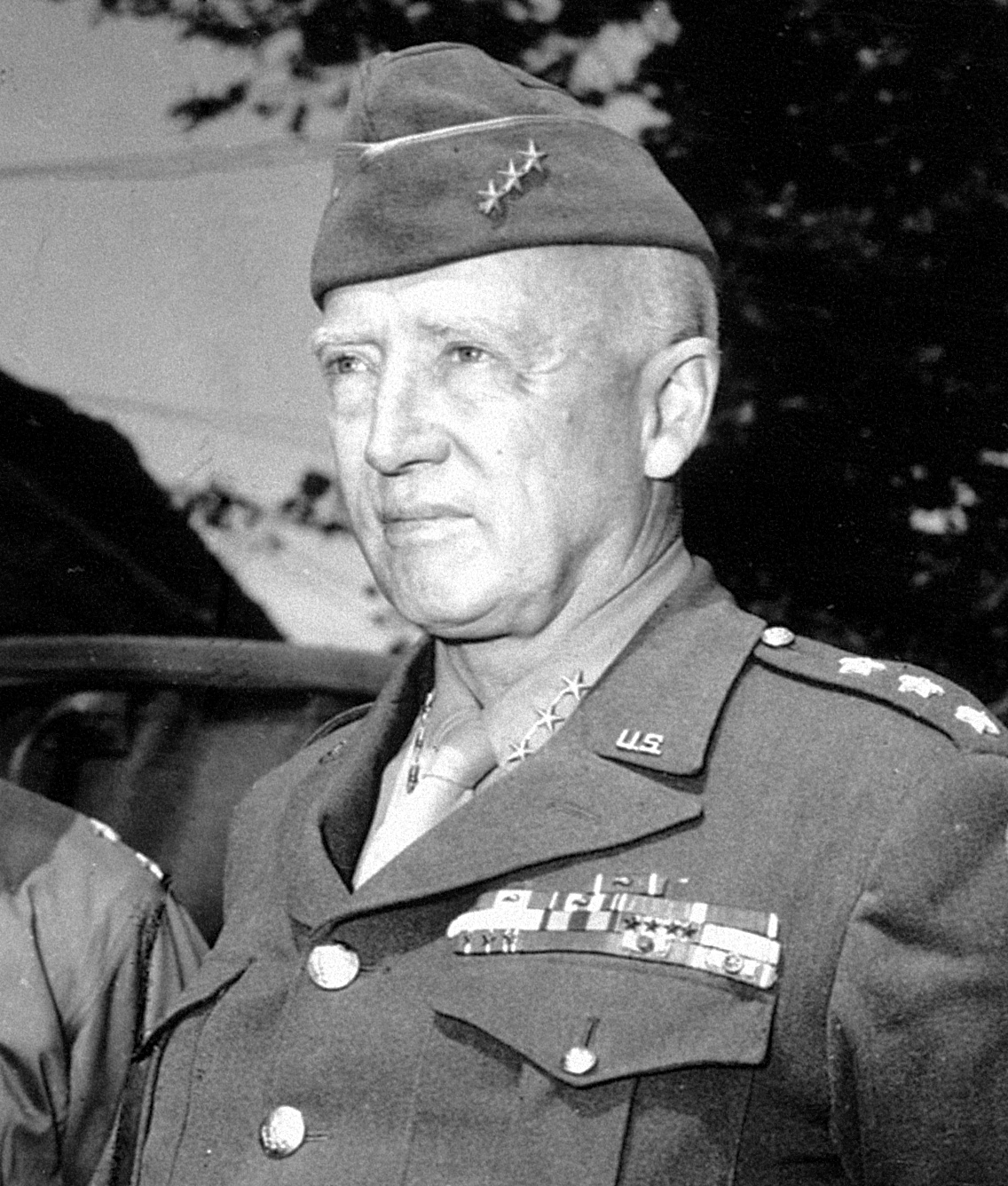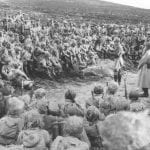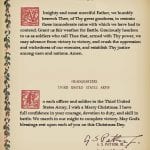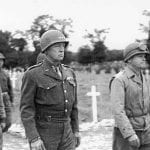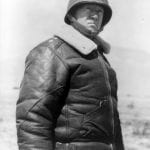At the end of 1943, while Patton’s commanders were deciding his fate, the allied leaders—Roosevelt, Churchill, and Stalin—met in Tehran to discuss strategy for defeating Germany and plans for the postwar world. Uncertain of the role, if any, he might play in the coming invasion of Europe, Patton took a sightseeing trip to the Holy Land and Malta.
The general was as affected by the Crusader sights as he was the Biblical locations. The general considered himself a descendant of the warriors, part of the same lineage of warriors who gladly risked their lives for a noble cause. But as a devout Christian—whatever the profanity in his speeches suggested otherwise—he couldn’t help but be moved by walking in the footsteps of Jesus. Yet he still viewed the Holy Land as a general, viewing the Exodus of the Israelites out of Egypt and into the Promised Land in terms of logistics, supply chains, and provisions.
December 14, 1943
We took off by plane for Jerusalem at 0700 and crossed the canal just south of Lake Tenes, which is near where the children of Israel crossed.
It never occurred to me until this flight that, at the time the Jews crossed, it was unnecessary for them to ford anything, because there is a stretch of desert from Bitter Lake to the Mediterranean which had no water on it. However, they did get across and Napoleon crossed at about the same place and also lost his baggage when the wind shifted.
From the canal we flew along the line of Allenby’s advance and crossed at Wadi El Arish at the spot where the battle occurred. It is a much less formidable obstacle than I had gathered from the books.
Beersheba and the surrounding country do not look too difficult, but certainly away from the wells the country is an absolute sand sea, and it is difficult to understand how Allenby ever moved a cavalry corps across it.
From Beersheba we flew over Hebron and Bethlehem and turned westward just south of Jerusalem, finally landing at Aqir, near the coast, where we were met with some cars and driven thirty miles to Jerusalem.
The only reason for calling Palestine a “land of milk and honey” is by comparison with the desert immediately surrounding it. It consists of nothing but barren stony hills on which a few olive trees eke out a precarious existence. We did not see a single beehive, although there were quite a number of mimosa trees.
On reaching Jerusalem, we were met by Major General D. F. McConnell, who commands the district. He gave us a British priest, who had lived a long time in Jerusalem, as a guide to see the sights.
We entered the city through the gate which Tancred stormed when the city was first taken (A.D. 1099). The Church of the Holy Sepulchre covers both the Tomb of Christ and also the place where the Cross stood. It is run by a composite group consisting of Catholics, Greeks, and Copts, and by a strange freak of chance, or British political insight, the doorkeeper is a Mohammedan.
It struck me as an anomaly that, during my entire visit to Jerusalem, I was guarded by four secret service men, and the oddest part of it was that, when I entered the Tomb, the secret service men came in with me. People must have very little confidence to fear assassination in such a place.
From the Tomb we went to the Crusaders’ Chapel where those who became Knights of Jerusalem were knighted. In this chapel is the sword which is supposed to have been used on these occasions. In my opinion it is a fake, since the pommel is not of the correct shape, nor has it sufficient weight. The pommels of Crusaders’ swords were usually carved in the form of a stone or a piece of lead, which in an earlier date had actually been tied there. This pommel was in the shape of a blunt acorn. The crossguard and the shape of the blade were correct.
From here we went to the place where the Cross had stood. Most of the mountain was cut away during the Roman occupation, when they filled up the Tomb and erected a Temple of Venus over both the Mount and the Tomb. However, there is an altar which is supposed to be on the exact spot where the Cross was erected.
While I was in this chapel, I secured a rosary for Mary Scally [his childhood nurse] and had it blessed at the altar.
After we had left the church, we followed the Way of the Cross, which is a dirty street, to the point where the Roman Forum had stood. I should think the distance is less than half a mile. In addition to the Stations of the Cross used by the Catholics, the Greeks have a number of extra ones, so that it is practically a day’s trip for a Greek priest to walk down the street, as they have to stop in front of each station.
From the Forum we got into the cars and drove to the Garden of Gethsemane, where there are still olive trees which just possibly may have been in existence at the time of the Crucifixion.
After lunching with the Commanding General, we drove back to the airfield and flew back to Cairo along the coast, passing over Gaza. Although I looked very carefully, I could see no indication of the fighting, but I did recognize the cactus hedge where the tanks got stuck. We reached Cairo just at dark, having completed in one day the trip which took the Children of Israel forty years to accomplish.
After the Holy Land, Patton headed to the Mediterranean island of Malta. Here he wrote much of the Knights of Malta and the rules of their order. As a career military man, Patton couldn’t help but be fascinated by their customs. He commented at length on the four vows that each knight took upon induction into the order: on poverty, chastity, humility, and obedience.
Patton recorded his thoughts in his journal:
Malta, which we reached at three o’clock, is quite different from the way I had pictured it. It is almost completely covered with villages and the areas between them are crowded with tiny fields. The only place where this crowding does not exist is on the airfields. . . .
The most interesting thing I saw is the library of the Knights of Malta. We were taken through this by the librarian. He speaks and reads in script nine languages, so he is perfectly capable of translating the valuable collection of manuscripts in the library.
One codex dating from 1420 and depicting the life of Saint Anthony, who spent his time being pursued by devils in the form of beautiful women, was particularly interesting to me because in one of the pictures it showed an armorer’s shop in which suits of armor, varying in date from early 1100 to 1400, were hung up for sale just as one hangs up clothes in a pawnshop. The point of interest is that most historians are prone to classify armor by dates, whereas here we have visual proof that as late as 1400 all types of armor, both mail and plate, were still being used.
Another codex which was interesting was one of the original printings of the Bible, using wood type. In this case all the capitals were omitted and subsequently illuminated by hand.
In order to be a Knight of Malta, it was necessary to have sixteen crosses of nobility, so that when anyone came up to be a knight, he had to present his genealogy, which was then studied by a college of heralds, and, if proven correct, permitted to join. Since all these genealogies, covering the knights from sometime in 1100 to date, are preserved in the library, it gives the greatest historical family tree in the world.
In addition to the requirement of sixteen crosses of nobility, a knight had to spend eighteen months at sea on the galleys as a fighter, and then work in a hospital.
The knights also had to take four vows—Poverty, Chastity, Humility, and Obedience. The vow of Poverty required him to give four-fifths of his then estate to the Order. However, if he was a successful knight, he received from the Order more than a hundredfold over what he gave, so that most of them died very rich. This was particularly true before 1800, when the knights had a sort of stranglehold on the privateering business in the Mediterranean and used their hatred for the Turks as a means of veiling their personally conducted piracy against Turks and against anyone else whom they could catch.
The vow of Chastity was not enforced except by one Grand Master, who, in order to discourage the amorous activities of his dependents, required that all the girls live across the harbor from the forts, so that when a knight wanted to see his lady-love, he had to row across and thereby bring great discredit upon himself. Apparently the discredit consisted of other knights cheering him on.
The vow of Humility was got around by the simple expedient of washing a poor man’s feet three times. The vow of Obedience was rigidly enforced.
This article is part of our larger selection of posts about the George S. Patton. To learn more, click here for our comprehensive guide to General Patton.
 |
 |
 |
This article is from the book Patton: Blood, Guts, and Prayer © 2012 by Michael Keane. Please use this data for any reference citations. To order this book, please visit its online sales page at Amazon or Barnes & Noble.
You can also buy the book by clicking on the buttons to the left.
Cite This Article
"Patton in the Holy Land" History on the Net© 2000-2024, Salem Media.
April 24, 2024 <https://www.historyonthenet.com/patton-in-the-holy-land>
More Citation Information.



